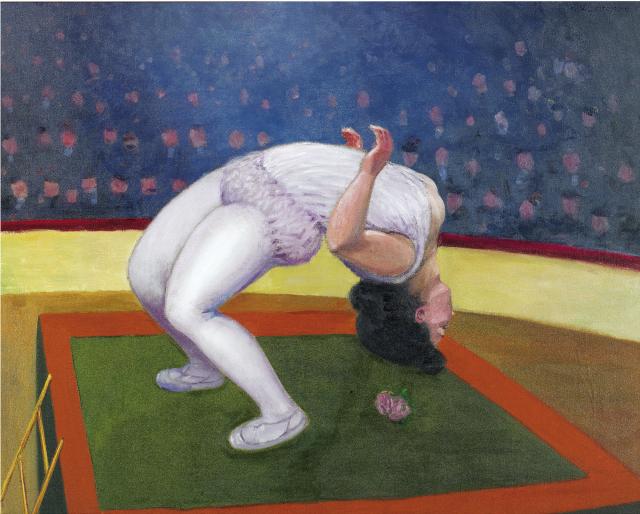In his career, Félix Vallotton was to produce over five hundred paintings devoted to women. Women are portrayed alone, naked, or inserted in enlarged compositions. Early in the 20th century, he abandons interiors and genre scenes, as well as the black-and-white engraving that has won him significant recognition, to concentrate on the female figure. And from 1907 on, it is the female nude that holds his attention completely.
Surely inspired by the circus shows with their dance and acrobatics that are all the rage at the turn of the century, Vallotton depicts here a contortionist seen in a backward arching movement. In his Livre de raison (or Record Book), the artist describes the painting in these terms, “Woman acrobat, mauve leotard, bending over backwards to seize a rose with her teeth. Evening circus effect”.
The canvas is organised around a few lines of force. A yellow strip divides the picture into two grounds. In the background, an abstract crowd is suggested by pinkish dots; and in the foreground, a square scene is arranged with a sure hand. Unlike the other works that treat the same theme, the artist focuses this time on the acrobat and not on, say, a bit of action taking place at the edge of the representation, amongst the audience. The figure is set off by an overhead lighting effect that forms a halo and creates a glow that falls on the arc made by the acrobat’s body. The bright colours, compact brushwork and heightened outlines build up a theatrical composition that spotlights a poised moment in the show.
Through an instant that hangs in the air, a frozen narrative, Femme acrobate (Woman Acrobat) offers an unusual, imposing, forthright staging of the scene. The acrobat’s robust physiognomy, her body roughly handled by the inelegant position she is holding, her stretched chest slipping from her bodice – all these elements indicate that the woman portrayed by Vallotton is observed as a curiosity would be, not as a source of desire or object of seduction. Vallotton isn’t looking to idealise the woman or glorify her beauty. Rather, he is turning an intrigued eye on a study subject.
Surely inspired by the circus shows with their dance and acrobatics that are all the rage at the turn of the century, Vallotton depicts here a contortionist seen in a backward arching movement. In his Livre de raison (or Record Book), the artist describes the painting in these terms, “Woman acrobat, mauve leotard, bending over backwards to seize a rose with her teeth. Evening circus effect”.
The canvas is organised around a few lines of force. A yellow strip divides the picture into two grounds. In the background, an abstract crowd is suggested by pinkish dots; and in the foreground, a square scene is arranged with a sure hand. Unlike the other works that treat the same theme, the artist focuses this time on the acrobat and not on, say, a bit of action taking place at the edge of the representation, amongst the audience. The figure is set off by an overhead lighting effect that forms a halo and creates a glow that falls on the arc made by the acrobat’s body. The bright colours, compact brushwork and heightened outlines build up a theatrical composition that spotlights a poised moment in the show.
Through an instant that hangs in the air, a frozen narrative, Femme acrobate (Woman Acrobat) offers an unusual, imposing, forthright staging of the scene. The acrobat’s robust physiognomy, her body roughly handled by the inelegant position she is holding, her stretched chest slipping from her bodice – all these elements indicate that the woman portrayed by Vallotton is observed as a curiosity would be, not as a source of desire or object of seduction. Vallotton isn’t looking to idealise the woman or glorify her beauty. Rather, he is turning an intrigued eye on a study subject.
